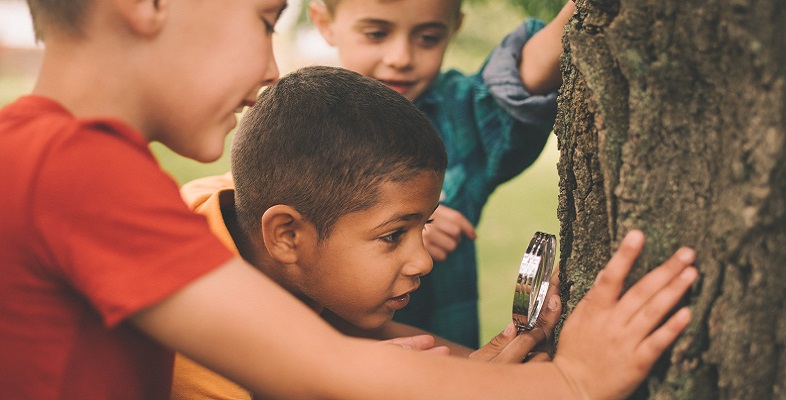2.2 Scientific vocabulary
The same word may have different meanings depending on the context in which it is used. Those supporting children need to be aware of these different meanings. Children’s ideas may become partly or completely misconceived due to confusion about vocabulary.
Activity 5 Everyday and scientific meanings
Consider the everyday meanings and the scientific meanings of these words. If you’re unsure of their scientific meaning, look them up. There’s a space provided for you to note down any observations you make.
| atmosphere | space | dense |
| reaction | energy | reflection |
| solution | cells | tissue |
Comment
In everyday language, these words are regularly used in ways that can vary quite a bit from their scientific meaning. For example, you might hear ‘she’s got so much energy’ or ‘I caught my reflection in the shop window’, while these words are used for quite specific purposes in biology and physics.
It is possible for children to use scientific words correctly in scientific conversations, but then find it difficult to express all the complex ideas behind the concept when asked to define or explain what they mean. Exploring their ideas through talking and observing can help to dispel some of their confusion or identify under-developed ideas. As you answer the questions in this course, consider whether scientific vocabulary is a barrier for you. Are you able to provide good definitions that would support primary-aged children’s learning? Or could some of your definitions mislead children and actually be unhelpful, as illustrated in the following activity?
Activity 6 Atoms and molecules
For each of the definitions provided in Table 3 for an atom (definitions 1-6) and a molecule (definitions 7-10), decide whether:
it is right
it is wrong
it could be potentially misleading
AND decide whether:
it would be helpful to an eleven-year-old learner
it would not be helpful to an eleven-year-old learner
Note your decision in the boxes beside each definition – and explain your reasoning if you can.
Definitions of ‘atom’
| |
| 1. The simplest structure in chemistry. It contains a nucleus with protons and neutrons, and electrons moving round in shells. | |
| 2. The smallest part of an element that can exist as a stable entity. | |
| 3. The building blocks of life, the LEGO® of nature. | |
| 4. The smallest particle of an element that still shows the chemical properties of the element. | |
| 5. The smallest particle that can be obtained by chemical means. | |
| 6. The smallest particle that can be found. It is made up of protons, neutrons and electrons. | |
Definitions of ‘molecule’
| |
| 7. The smallest particle of matter that can exist in a free state. | |
| 8. Something that is formed by two atoms bonding together. | |
| 9. The smallest portion of a substance that is capable of existing independently and retaining the properties of the original substance. | |
| 10. Group of two or more atoms bonded together. A molecule of an element consists of one or more like atoms; a molecule of a compound consists of two or more different atoms bonded together. | |
Answer
Definitions of ‘atom’
| |
| 1. The simplest structure in chemistry. It contains a nucleus with protons and neutrons, and electrons moving round in shells. | Whether it is the simplest structure in chemistry is debatable and potentially confusing. The reference to electrons moving round in shells is not helpful because children will have different ideas about ‘shells’ than those that apply to atoms. |
| 2. The smallest part of an element that can exist as a stable entity. | True, but not helpful because of the use of the term ‘stable entity’. |
| 3. The building blocks of life, the LEGO® of nature. | True. This is probably the most helpful for younger primary children because it avoids other complicated words and uses something they are more likely to be familiar with. |
| 4. The smallest particle of an element that still shows the chemical properties of the element. | True, but this explanation requires an understanding of chemical properties. |
| 5. The smallest particle that can be obtained by chemical means. | True, but not useful because ‘by chemical means’ adds complexity. |
| 6. The smallest particle that can be found. It is made up of protons, neutrons and electrons. | True. This explanation is useful, even though it includes protons, neutrons and electrons. They are easier concepts to understand than expressions like ‘chemical means’ or ‘stable entity’. |
Definitions of ‘molecule’
| |
| 7. The smallest particle of matter that can exist in a free state. | True, but not very useful because of the use of the term ‘free state’. |
| 8. Something that is formed by two atoms bonding together. | True and useful because it is put in simple terms. |
| 9. The smallest portion of a substance that is capable of existing independently and retaining the properties of the original substance. | True, but not useful because it is too complicated. |
| 10. Group of two or more atoms bonded together. A molecule of an element consists of one or more like atoms; a molecule of a compound consists of two or more different atoms bonded together. | True, but takes the definition into elements and compounds. |
Extending children’s scientific vocabulary will help them to build on their understanding, develop their thoughts and to express ideas. However, just because a child uses a scientific term, this does not necessarily mean that they understand it! Through questioning, their level of understanding can be assessed. Embedding new scientific terminology within meaningful texts, or giving children the chance ‘to use them in discussion, debates and their own writing’ will make them more likely to understand and retain learning (Kearton, 2011).
